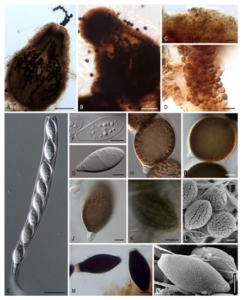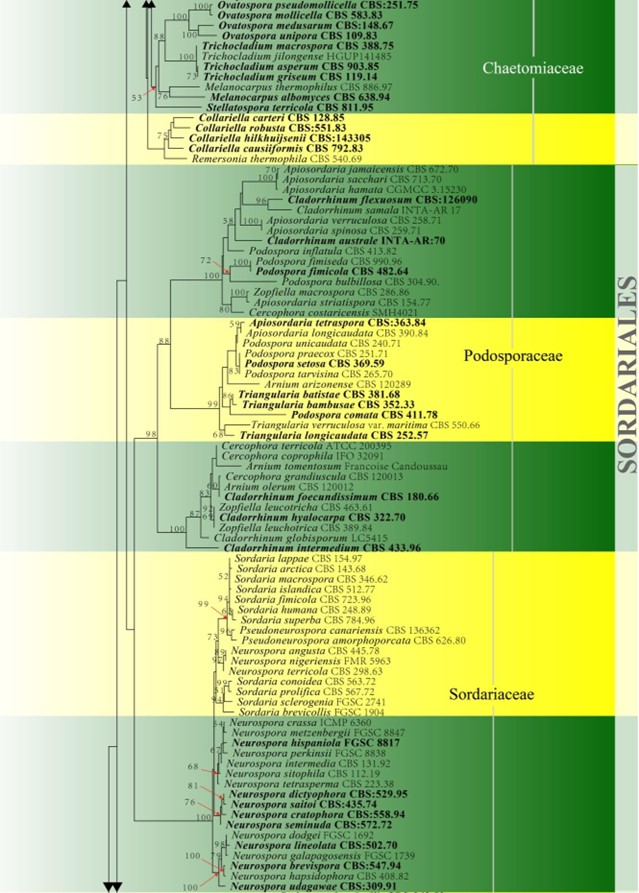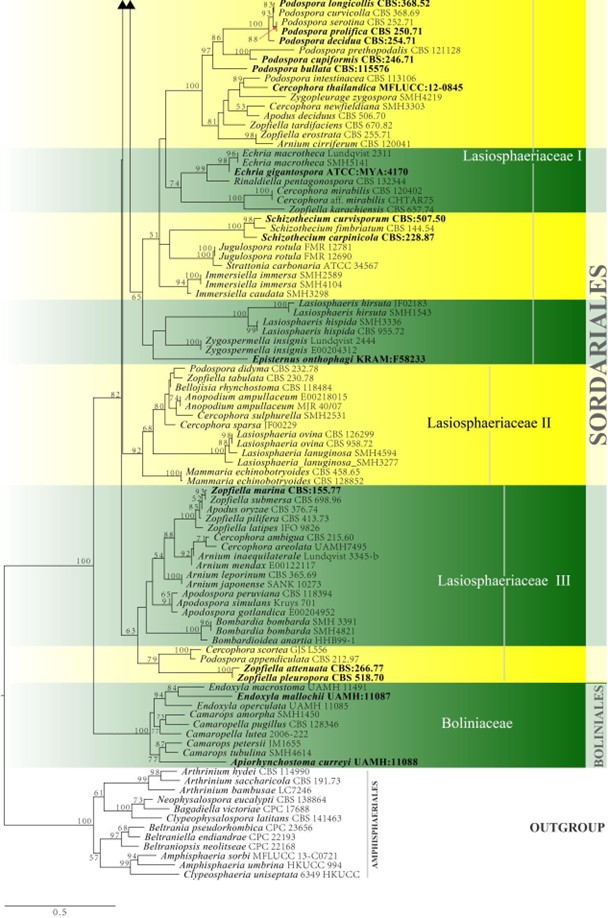Jugulospora N. Lundq., Symb. bot. upsal. 20(no. 1): 256 (1972), emend. Y. Marin & Stchigel.
Synonym: Rhexosporium Udagawa & Furuya, Trans. Mycol. Soc. Japan 18: 302. 1977.
MycoBank number: MB 2538; Index Fungorum number: IF 2538; Facesoffungi number: FoF 13304; 1 species with sequence data.
Sexual morph Ascomata ostiolate, covered with pale brown, flexuous, septate, thick-walled hairs; neck dark brown to black, composed of papillate cells disposed around the ostiole. Ascomatal wall membranaceous, semi-transparent, 3–9-layered, outer cells isodiametric. Paraphyses filiform. Asci unitunicate, eight-spored, cylindrical, with a thin apical ring. Ascospores at first one-celled, hyaline, clavate, early septate; upper cell brown, navicular, globose, or obovoid, warted, finely granulated, or pitted, sometimes with warts arranged forming ridges or large spots, with an apical germ pore; lower cell hyaline, conical to cylindrical, smooth-walled to slightly warted, collapsing; gelatinous sheath rarely present, hyaline, thin. Asexual morph absent or present. Conidia hyaline to pale brown, almost smooth-walled, ovate to elongate, produced laterally or terminally on undifferentiated hyphae, solitary.
Type species – Jugulospora rotula (Cooke) N. Lundq.
Notes – The genus Jugulospora was introduced by Lundqvist to accommodate the Sphaeria rotula based on its verrucose ascospores with anastomosing warts arranged in large spots. The molecular data demonstrated that A. globosa, A. hispanica, and R. terrestre, also with warted ascospores, are synonymous with J. rotula. Rhexosporium was proposed as a new genus by Udagawa and Furuya due to the presence of the longitudinal ridges in the upper cell of the ascospores, even though these authors cited a similar ascospore ornamentation in the genera Apiosordaria and Jugulospora. We noticed that such ascospore ridges seen under SEM (from the pictures taken by those authors) were really in a linear arrangement of warts and, consequently, not differing with respect to the ornamentation of those of J. rotula. Based on the early ascospore septation, the absence of staining of the ascal apical ring by cotton blue, and the presence of paraphyses, Lundqvist highlighted the close similarity between Jugulospora and Strattonia carbonaria. Our study confirmed the phylogenetic relationship among them, already demonstrated in previous phylogenetic studies. Therefore, we transferred Strattonia carbonaria to Jugulospora as J. carbonaria. Although Strattonia is an older name than Jugulospora, the type species of that genus, S. tetraspora, has an ascomatal neck with rigid, cylindrical, septate, long hairs and ascospores with a gelatinous sheath, features that do not match with those of Jugulospora. Hence, the genus Strattonia should be reduced to those species that share the morphology of the type species. Moreover, the type strains of A. antarctica and A. vestita clustered in the Jugulospora clade but formed independent lineages. Therefore, both species are transferred to Jugulospora.

Figure 1 – Morphology of Jugulospora. Ascoma. (A) Jugulospora rotula FMR 12428. (B) Jugulospora rotula FMR 12690. Detail of the papillate neck. (C,D) Jugulospora carbonaria ATCC 34657. Ascus. (E) Jugulospora rotula FMR 12428. Immature ascospores. (F,G) Jugulospora rotula FMR 12428. Different ascospore morphology of Jugulospora rotula. (H) CBS 12690. (I) CBS 110113. (J) CBS 110112. (K,L) FMR 12428. Ascospores. (M) Jugulospora carbonaria ATCC 34567. (N) Jugulospora antarctica IMI 381338. Bars: (A,B) = 100 μm; (C,E) = 20 μm; (D) = 10 μm; (E) = 15 μm; (F–N) = 5 μm.
Key to species of Jugulospora
| 1. Ascospores pitted, with gelatinous sheath | J. vestita |
| 1. Ascospores warty or finely granulated, without gelatinous sheath | 2 |
| 2. Ascospores warty | J. rotula |
| 2. Ascospores finely granulated | 3 |
| 3. Ascomata with short neck | J. carbonaria |
| 3. Ascomata with long neck, up to 400 μm | J. antarctica |

Figure 23 – Phylogram generated from maximum likelihood analysis based on combined LSU, ITS, tub2 and rpb2 sequence data of Sordariales. Related sequences were taken from Wang et al. (2016b). Two hundred and fifty-seven strains are included in the combined analyses which comprised 2717 characters (855 characters for LSU, 480 characters for ITS, 860 characters for tub2, 522 characters for rpb2) after alignment. Members of Amphisphaeriales are used as outgroup taxa. Single gene analyses were carried out and the phylogenies were similar in topology and clade stability. The best RAxML tree with a final likelihood value of -59082.079074 is presented. Estimated base frequencies were as follows: A = 0.238795, C = 0.266829, G = 0.275292, T = 0.219085; substitution rates AC = 1.483472, AG = 3.436969, AT = 1.859704, CG = 1.064423, CT = 6.934931, GT = 1.000000; gamma distribution shape parameter a = 0.757314. Bootstrap support values for ML greater than 50% are given near the nodes. Ex-type strains are in bold. The newly generated sequences are indicated in blue.

Figure 23 – Continued.

Figure 23 – Continued.
Species
